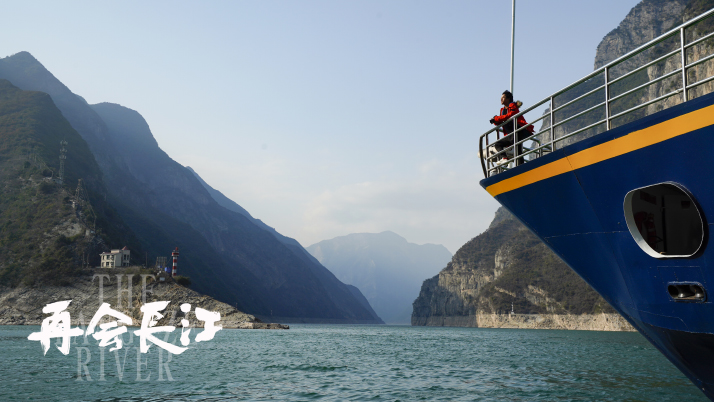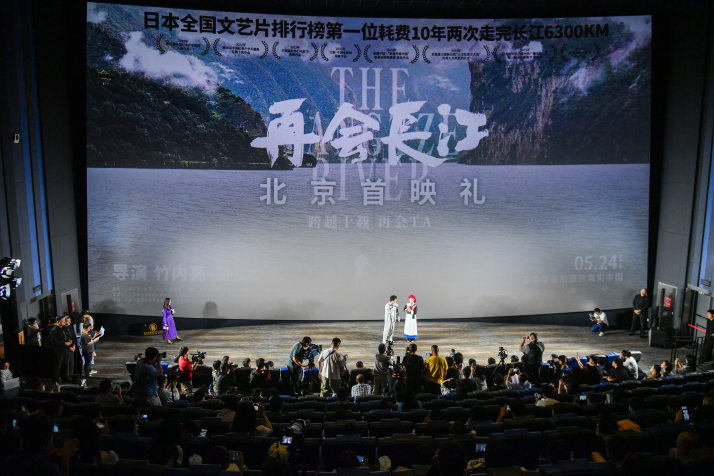| China |
| Film about Yangtze River captures evolving landscape of Chinese society | |
|
|
 A still of documentary film The Yangtze River (COURTESY PHOTO)
In 2011, the documentary A Journey to the Yangtze River by Japanese director Ryo Takeuchi became a hit in both China and Japan. The documentary portrayed the lives of several people from different social backgrounds, as well as the local conditions and customs along different parts of the Yangtze. Stretching 6,300 km, the Yangtze is the longest river in China and the third longest one in the world, earning it the moniker of the nation's River of Life. A decade later, Takeuchi, who had since relocated to Nanjing, Jiangsu Province, in the lower reaches of the Yangtze, decided to embark on a new journey tracing the iconic river's entire length. The resulting documentary series, titled The Yangtze River, garnered a high rating of 9.3 out of 10 on Chinese review platform Douban after its debut on Chinese streaming services in February 2022. Takeuchi has now reworked the series into a feature film, which was released across Chinese cinemas on May 24. He hopes this new cinematic creation will offer audiences an objective glimpse into an engaging China through his perspective as a Japanese director. Additionally, he embarked on this project with the goal of sharing his personal feelings about the river and the changes he has witnessed along it over the past decade. Changing lives When Rinchen Cimu first crossed paths with Takeuchi in 2011, she was 17. Born and raised in Shangri-La, a mountain paradise in Yunnan Province located on the upper reaches of the Yangtze, this Tibetan girl had never ventured beyond her hometown. At the time, she was working at a scenic area, earning money by taking photos with tourists. Dressed in traditional Tibetan clothing and holding baby lambs, she charged 5 yuan ($0.69) per photo. However, due to her shy nature, Rinchen Cimu struggled to actively engage with tourists, resulting in meager daily earnings of just a few dozen yuan. During their chance encounter, Rinchen Cimu summoned the courage to approach Takeuchi and his crew and ask them a few questions, such as whether planes in the sky have designated routes and how a 100-story building gets constructed. Impressed by her curiosity, the production team decided to take Rinchen Cimu and her mother on a trip to the far-off metropolis of Shanghai, over 2,900 km away from their hometown. This journey opened Rinchen Cimu's eyes to the world and proved to be a life-changing experience. Upon returning home, she wrote a heartfelt thank-you letter to Takeuchi, revealing her dream of opening a homestay. Ten years later, Takeuchi returned to the very spot where he had first met Rinchen Cimu during the shooting of The Yangtze River, and he was astonished to learn that she had in fact realized her dream. Rinchen Cimu had opened a homestay, designing the interiors of the rooms herself. The name of her establishment, "Aurora," was inspired by the high-rise building she had seen during their trip to Shanghai. The Yangtze River also tells other stories of transformation along the river. During their trip in 2021, Takeuchi and his crew documented the lives of "Bangbang porters," manual laborers in Chongqing, a mountain city located on the upper reaches of the Yangtze. They carry packages for travelers and merchants up and down the sloping villages, using a pole known as a Bangbang. With the development of the express delivery industry and improved urban transportation, the Bangbang porters are disappearing fast. "Their stories reflect how Chinese people are changing, as well as the incredibly fast economic and social development of the country," Takeuchi told Beijing Review.  Japanese director Ryo Takeuchi (center left) and Rinchen Cimu (center right), the Tibetan protagonist, attend an event promoting the release of the documentary film The Yangtze River in Beijing on June 5 (WEI YAO)
Emotional connection In April, the film was released in more than 400 theaters in Japan to wide acclaim, securing the top spot on the national Japanese art film box office chart. "Japanese documentary films have rarely been able to get nationwide theatrical releases, especially those focused on China, which tend to have a more niche audience. However, The Yangtze River was screened in over 400 theaters across Japan. For me, this is the first time I've experienced this level of attention and exposure for a documentary film," Takeuchi said. "One of the things that impressed me most was seeing both Chinese and Japanese audiences laugh and shed tears during the same scenes. Such emotional connection is invaluable," the director remarked. Takeuchi specifically noted that Japanese audiences resonated deeply with the story of 71-year-old Bangbang porter Jiang Peiqing. This is because Japan has many traditional artisans who dedicate their lives to mastering just one craft. Now, as they age, many struggle to keep up with the times. "So Japanese viewers saw themselves in Jiang, and they were able to deeply empathize with his emotional journey. His story made the strongest impression on them," he explained. Since moving to China in 2013, Takeuchi has devoted himself and his art to promoting communication between China and his home country, and made a series of Chinese-themed documentaries, such as The Reason I Live Here, using his camera to record Chinese people living in Japan and Japanese people living in China. He also produced several documentaries detailing China's efforts in combating the COVID-19 pandemic, i.e., Long Time No See, Wuhan and China's Post-Pandemic Era: Winning Against All Odds. In September 2023, Takeuchi won the Orchid Award, which was initiated by China International Communications Group to recognize non-Chinese individuals and organizations that have furthered international cultural exchange and understanding between China and other civilizations. So how can creators tell China's stories well? Takeuchi emphasized the importance of realism, stating that authentic portrayals are usually the ones that resonate most strongly with audiences. His goal is to maintain objectivity and impartiality in his works, to allow audiences to form their own opinions on China. "Some documentaries about China made by Japanese, European and American media tend to focus on criticisms, whereas some Chinese-made documentaries are doing the opposite," he said, adding that although his documentaries cannot be completely objective, he tries to be relatively neutral and authentic. "As I document, I seek to better understand China. I hope that more people can learn about the real China through my films, even if just a little," Takeuchi said. Looking ahead, he plans to explore the Yellow River, China's second longest river often dubbed the Mother River and known as the cradle of Chinese civilization. Copyedited by Elsbeth van Paridon Comments to luyan@cicgamericas.com |
|
||||||||||||||||||||||||||||
|